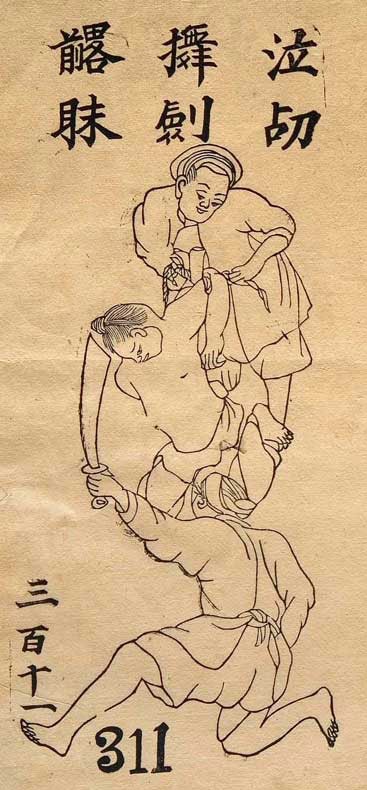Ancient Vietnamese dynasties gave thieves some of the harshest punishments, sometimes as harsh as murder crime.
When @SailorNeptune; and I read records of Tonkin and Cochinchina by Western authors of the 17th century, we were astonished at how harshly thieves were punished by the court law (having all their fingers cut off).
Some research into Vietnamese annals by Tran Quang Duc revealed a more detailed account of how Vietnamese dynasties dealt with thieves. The crimes discussed below are only civil crimes (stealing from normal persons and households).
Lý dynasty
We don't have as much detail into laws of the Lý dynasty but we know that buffalo thieves were beaten 100 times by large staff. If the buffaloes were killed, the thieves had to compensate to the owner and perform penal labor in the household of the owner.
It should be noted that the punishment for murder crime in the Lý dynasty (as of 1125) was 100 beats by staff and 50-character carve into the face. So comparatively, stealing was punished almost as harshly as murder crime.
Later, historians of the Lê dynasty called laws of the Lý dynasty "too lax". It's understandable because the national religion in the Lý era was Buddhism, which overall was more tolerant than other religions.
Trần dynasty
Trần dynasty laws specified 3 degrees for stealing crime:
- First offense: Beaten 80 times by staff, carved into the face 2 characters: Phạm Đạo 犯盜. Additionally, the thieves had to compensate at least 9/10 the value of stolen property. If he can't compensate, then his wives and children would be made into slaves/servants for the owner of the stolen properties.
- Second offense: His hands and limbs would be chopped off.
- Third offense: Beheading
Lê dynasty
We have more detailed accounts of Lê dynasty laws (mainly because more documents survived). Stealing crime in Lê dynasty are punished as followed:
- First offense: exile
- Second or repeated offense: beheading
- Stealing properties of little value during the day: penal labors, compensation to the owner.
Women are given lighter punishment (doesn't specify how in this case, but the Lê codes always gave women lighter punishment than men when committed the same crime).
In some cases, the thieves had their limbs cut off, in other cases, the thieves had their fingers chopped off.
Nguyễn lords in the south (17th-18th century in the south)
If the stolen properties were of high value: beheading
If the stolen properties were not of high values (eg: chicken)
- First offense: Chop off one finger
- Second offense: chop off another finger (or all the fingers?)
- Third offense: Cut off the ears
- Fourth offense: Beheading
Nguyễn dynasty
If the thieves failed to obtain property: 50 whips
If the thieves successfully obtained the properties: whips + carving characters into right limb for the first offense, left limb for the second offense, and beheading for the third offense.
More details to the law:
Stealing from 1 tael to 10 taels: beaten by staff 70 times
Stealing 20 taels: beaten by staff 80 times
Stealing 30 taels: 90 times
Stealing 40 taels: 100 times
Stealing 50 taels: beaten by staff 50 times + penal labor for a year
Stealing 60 taels: beaten by staff 70 times + penal labor for two years
...
Stealing 100 taels: whipped 100 times + exiled 2000 miles
Stealing 120 taels or above: Hang!





